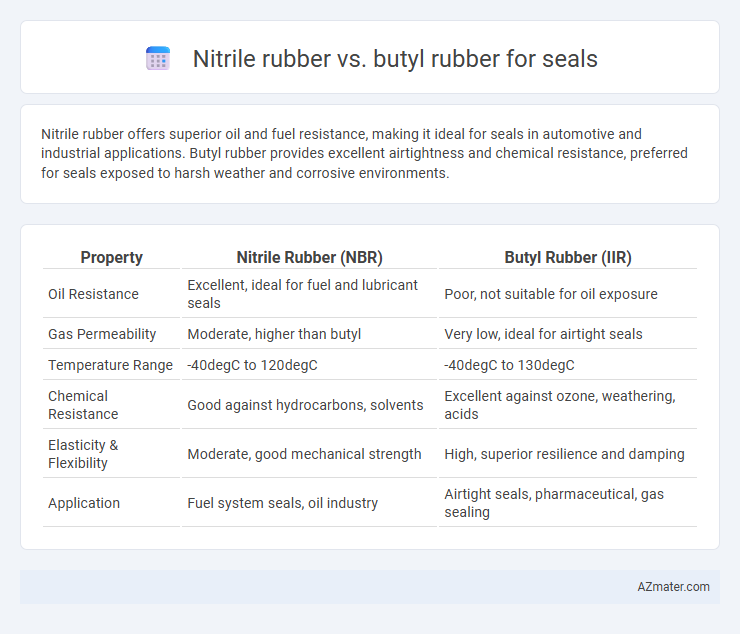Nitrile rubber offers superior oil and fuel resistance, making it ideal for seals in automotive and industrial applications. Butyl rubber provides excellent airtightness and chemical resistance, preferred for seals exposed to harsh weather and corrosive environments.
Table of Comparison
| Property | Nitrile Rubber (NBR) | Butyl Rubber (IIR) |
|---|---|---|
| Oil Resistance | Excellent, ideal for fuel and lubricant seals | Poor, not suitable for oil exposure |
| Gas Permeability | Moderate, higher than butyl | Very low, ideal for airtight seals |
| Temperature Range | -40degC to 120degC | -40degC to 130degC |
| Chemical Resistance | Good against hydrocarbons, solvents | Excellent against ozone, weathering, acids |
| Elasticity & Flexibility | Moderate, good mechanical strength | High, superior resilience and damping |
| Application | Fuel system seals, oil industry | Airtight seals, pharmaceutical, gas sealing |
Introduction to Nitrile and Butyl Rubber
Nitrile rubber, known for its excellent resistance to oils, fuels, and other chemicals, is widely used in sealing applications requiring durability and flexibility in harsh environments. Butyl rubber offers superior impermeability to gases and excellent resistance to weathering, ozone, and aging, making it ideal for seals exposed to extreme conditions. Both materials provide unique advantages in seal manufacturing, with nitrile excelling in hydrocarbon resistance and butyl favored for airtight performance.
Chemical Structure Comparison
Nitrile rubber (NBR) consists primarily of acrylonitrile and butadiene copolymers, featuring polar nitrile groups that provide excellent resistance to oils and fuels. Butyl rubber (IIR), made from isobutylene with a small amount of isoprene, has a saturated hydrocarbon backbone that offers superior impermeability to gases and exceptional resistance to heat and chemicals. The polar nitrile groups in NBR enhance solvent resistance, while the saturated structure of butyl rubber gives it greater chemical stability and durability in harsh environments.
Key Properties of Nitrile Rubber for Seals
Nitrile rubber (NBR) exhibits excellent resistance to oils, fuels, and chemicals, making it ideal for seals in automotive and industrial applications. Its high tensile strength and flexibility at low temperatures ensure durable performance under dynamic conditions, while its abrasion and tear resistance extend seal lifespan. Nitrile rubber's compatibility with petroleum-based fluids distinguishes it from butyl rubber, which excels in gas impermeability but lacks the same chemical resistance.
Key Properties of Butyl Rubber for Seals
Butyl rubber excels in seal applications due to its superior impermeability to gases and excellent resistance to heat, chemicals, and ozone, making it ideal for maintaining airtight and watertight seals. Its low permeability and high flexibility at low temperatures ensure durable performance under harsh environmental conditions, outperforming nitrile rubber in moisture and weather resistance. Butyl rubber's ability to maintain seal integrity in high-temperature and oxidizing environments is critical for long-lasting sealing solutions in automotive and industrial sectors.
Resistance to Chemicals and Oils
Nitrile rubber exhibits superior resistance to oils, fuels, and many chemicals, making it ideal for seals exposed to petroleum-based fluids and hydraulic oils. Butyl rubber offers excellent resistance to polar solvents, ozone, and weathering but has lower resilience against petroleum oils and solvents. Choosing between nitrile and butyl depends on specific chemical exposure, with nitrile preferred for hydrocarbon environments and butyl for exposure to harsh weather and polar chemicals.
Temperature Performance Differences
Nitrile rubber exhibits excellent resistance to temperatures ranging from -40degC to 120degC, making it suitable for seals exposed to moderate heat and cold conditions. Butyl rubber outperforms nitrile in low-temperature flexibility, maintaining seal elasticity down to -50degC, while also withstanding temperatures up to 130degC without degradation. The superior thermal stability and excellent ozone resistance of butyl rubber make it ideal for seals in extreme temperature fluctuations and harsh environments.
Durability and Longevity in Sealing Applications
Nitrile rubber offers excellent resistance to oils, fuels, and chemicals, making it highly durable for dynamic sealing applications exposed to petroleum-based fluids. Butyl rubber, characterized by superior impermeability to gases and resistance to weathering, excels in longevity for static seals exposed to harsh environmental conditions such as ozone and UV radiation. Choosing between nitrile and butyl rubber depends on the specific sealing environment, with nitrile providing enhanced wear resistance and butyl ensuring prolonged performance under extreme atmospheric exposure.
Applications: Best Use Cases for Nitrile Seals
Nitrile rubber seals excel in applications requiring exceptional resistance to oils, fuels, and hydrocarbons, making them ideal for automotive fuel systems, hydraulic hoses, and industrial machinery. Their superior abrasion resistance and ability to perform in temperatures ranging from -40degC to 120degC make nitrile seals highly suitable for dynamic sealing situations exposed to harsh environments. Butyl rubber, while offering excellent impermeability and resistance to heat and ozone, is better suited for applications needing airtight seals, such as inner tubes and pharmaceutical closures.
Applications: Best Use Cases for Butyl Seals
Butyl rubber seals excel in applications requiring superior gas and moisture impermeability, such as in pharmaceutical packaging, inner linings for tires, and airtight seals in automotive and aerospace industries. Their outstanding resistance to aging, ozone, and extreme temperatures makes them ideal for use in chemical processing equipment and protective seals in HVAC systems. Butyl seals outperform nitrile rubber in environments exposed to harsh weather and prolonged UV exposure, ensuring long-term durability and reliable performance.
Choosing the Right Rubber for Your Seal Needs
Nitrile rubber offers excellent resistance to oils, fuels, and chemicals, making it ideal for automotive and industrial seals exposed to harsh environments. Butyl rubber provides superior gas impermeability and weather resistance, making it suitable for seals in HVAC systems, medical devices, and applications requiring airtight performance. Choosing the right rubber depends on the specific sealing requirements, such as chemical exposure, temperature range, and flexibility needed for optimal durability and effectiveness.

Infographic: Nitrile rubber vs Butyl rubber for Seal
 azmater.com
azmater.com